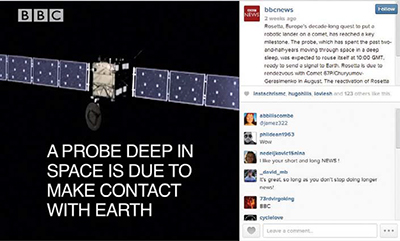News for Today’s Mobile Social Media Viewers

Gary Arlen Talk about short-attention-span TV! The BBC has been testing 15-second video “newscasts” beamed to tablets and smartphones. The Beeb’s video headlines “show” is tortuously long compared to the 6-second news videos that New York-based “NowThis News” has been producing since last year. “NowThis” also runs 15- and 30-second newscasts and produces even longer segments.
Both explorations into short-form video news are initially aimed at social media platforms, especially Instagram’s ability to deliver videos. Steve Herrmann, head of BBC News Online, acknowledges that the initial month-long trial, which started in mid-January, reflects the changing audience patterns. December 2013 marked the first time that mobile and tablet viewing of BBC content was greater than desktop use, Herrmann told Britain’s Guardian newspaper.
The BBC has been testing 15-second video “newscasts” beamed to tablets and smartphones.

NEWS IN A HURRY
NowThis, which last month received significant but undisclosed financial backing from NBC, is “working on native content and native advertising with brands,” Steven Belser, vice president for production and creative services of NowThis Media, told TV Technology. The company is working with Instagram as well as Vine, Snapchat, Google+ Tumblr and other websites to deliver syndicated news content. Much of NowThis’s short-form video comes from NBC resources, and many “shows” conclude with a tune-in message for NBC News telecasts.
Collectively the very short-form news headline services such as Instafax and NowThis reflect the movement of video newscasts to portable platforms. Unlike mobile DTV embedded into broadcast signals, these products are running, for now at least, via conventional wireless telecom bandwidth. Both Instafax and NowThis cater to time-pressed viewers who want professionally produced news, but want it in a hurry.
BBC News acknowledges that the Instafax name pays homage to “Ceefax,” the pioneering teletext service that BBC ran for more than 30 years until shuttering it in 2012. Ceefax was transmitted as a signal embedded within the broadcast signal, initially in the vertical blanking interval of analog TV transmissions.
For the trial, BBC is producing and uploading at least three Instafax newscasts per day. The typical Instafax format is three images—either still photo or motion video—with a few words superimposed in san-serif white letters atop the images. Serially, the words and pictures tell a specific story, such as one about Iran’s nuclear program or a Korean credit card incursion. Alternatively, the three segments sometimes cover different headlines; a recent Instafax feed had three separate stories about Ukraine protests, Syria peace talks and Grammy winners.
There is non-intrusive ambient audio behind each video clip, although no verbal sound bites or news reader (anchor) descriptions. The current version does not include hyperlinks to any other BBC news site, nor can the viewer share the Instafax feed with social media friends. One British blogger commented that “voiceovers [would] convey the idea faster.”
An anonymous BBC official, cited in blog comments about Instafax, allegedly explained that the segments can be produced faster and less expensively without voiceovers, but that after the initial test, the BBC will determine whether that will change if the service is introduced as a regular production.

Patricia Fili-Krushel, NBCUniversal News GroupREACHING THE YOUNGER AUDIENCE
At NowThis, every segment features a stand-up announcer or voiceover audio. Recent clips ranged from Secretary of State John Kerry’s testimony—14 seconds of it—at a congressional hearing to a one-minute history of the Marlboro man and how many of the actors died from lung diseases.
NowThis News, which uses the slogan “The News In Your Pocket,” produces more than 50 daily video updates for Facebook, Instagram, Snapchat, Twitter, Vine, YouTube plus Apple and Android apps. Since its inception, it has created more than 10,000 short videos, most of them timely news items but many of them “evergreen” features or celebrity reports. It is developing archives of related videos, currently bundled into six main categories: U.S. World, Entertainment, Politics, Food and Science/Technology.
Sports and business, usually mainstays of online news services, are notably absent on NowThis, although in recent weeks there was extensive Olympics video material. None of the video seemed to come from NBC, the U.S. broadcaster for the Olympics, but the NowThis coverage could certainly be identified as enhancing its high-profile investor’s high-priced February programming centerpiece.
NBC’s rationale for backing NowThis is the quest for younger audiences. Patricia Fili-Krushel, chairman of the NBCUniversal News Group, said in a statement that the company knows that “news consumption among younger audiences continues to grow, but in order to reach that audience, we need to continue to create video for the platforms they use most.”
NowThis currently carries no advertising, but Belser says the company sees “a transition to native advertising.” Although declining to explain how such revenue-producing commercials would work, he hinted at the creation of vertical content silos that would feature news and information that lends itself to targeted advertising.
Both Instafax and NowThis News, along with other online and mobile video news ventures, such as Net2TV’s “Portico” newscasts are counting on young viewers’ short-attention spans and quest for non-traditional TV newscasts. Still unclear is whether—or how—viewers will discover these newscasts, or if there is some “push” technology in the background that will enable the producers to send these short shows to interested audiences without becoming some sort of video spam.
Perhaps the most fascinating part of the short-form newscasts is their integration from the start with social media platforms, such as Instagram. The deals may augur improved collaboration between the different cultures of broadcast news and social media, not to mention the economic bases of each participant.
Conceptually, Instafax and NowThis provide divergent examples of how news is changing. One thing for sure: it’s not only faster, but shorter.
Gary Arlen is president of Arlen Communications LLC, a research and consulting firm. He can be reached atwww.arlencom.com.
Get the TV Tech Newsletter
The professional video industry's #1 source for news, trends and product and tech information. Sign up below.
Gary Arlen, a contributor to Broadcasting & Cable, NextTV and TV Tech, is known for his visionary insights into the convergence of media + telecom + content + technology. His perspectives on public/tech policy, marketing and audience measurement have added to the value of his research and analyses of emerging interactive and broadband services. Gary was founder/editor/publisher of Interactivity Report, TeleServices Report and other influential newsletters; he was the long-time “curmudgeon” columnist for Multichannel News as well as a regular contributor to AdMap, Washington Technology and Telecommunications Reports; Gary writes regularly about trends and media/marketing for the Consumer Technology Association's i3 magazine plus several blogs.

